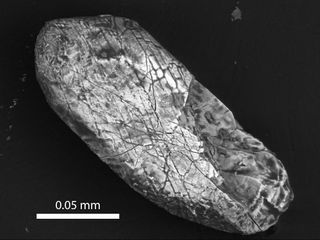Oldest Crystals on Earth Originated in Asteroid Craters

The oldest pieces of rock on Earth, zircon crystals, may have formed in craters left by asteroid impacts early in the planet's life.
Zircon crystals are more than 4 billion years old. Since the Earth itself is just over 4.5 billion years old, these ancient crystals can offer insight into the planet's history. Fifteen years ago, the crystals first made headlines, when research into the rocks' formation revealed the presence of water on Earth's surface soon after the planet formed.
Since that research was published, scientists have looked further to zircon crystals in hopes of finding other answers about the planet's history. [When Space Attacks: The 6 Craziest Meteor Impacts]
Scientists previously believed that the ancient zircon crystals were formed when tectonic plates collided, in similar processes to the disruption that created mountain ranges, volcanic activity and earthquakes.
However, most researchers date plate tectonics' beginning to about 3 billion years ago. Thus, zircon crystals were formed about 1 billion years before tectonic plates could have created the rocks.
In the new research, out of Trinity College Dublin in Ireland, researchers pursued a hypothesis that the crystals formed inside impact craters that were created when asteroids slammed into a young Earth.
To test their idea, the researchers collected zircons from the Sudbury impact crater in Ontario, Canada — one of the best-preserved large impact craters, and Earth's second oldest confirmed crater, at nearly 2 billion years old. In analyzing these younger zircons, the scientists found that the newer rocks were were indistinguishable from the ancient set.
Sign up for the Live Science daily newsletter now
Get the world’s most fascinating discoveries delivered straight to your inbox.
"What we found was quite surprising," Trinity researcher and co-author of the study Gavin Kenny said in a statement. "Many people thought the very ancient zircon crystals couldn't have formed in impact craters, but we now know they could have."
The impact of these asteroids — which pummeled the Earth, moon and inner planets of the solar system — would have melted the Earth’s crust to form lava lakes. As the area around the impact crater was heated and began to cool, the conditions would have allowed zircon to cystalize, Kenny explained to Live Science.
Determining the crystals' origins will help scientists continue to piece together an idea of what the planet's early years looked like, Kenny said, and how life began to emerge on Earth.
"Our new finding is going to fill in more of what we know about the Earth," Kenny said.
Follow Kacey Deamer @KaceyDeamer. Follow Live Science @livescience, on Facebook & Google+. Original article on Live Science.

